Mains electricity by country
Mains electricity by country includes a list of countries and territories, with the plugs, voltages and frequencies they commonly use for providing electrical power to low voltage appliances, equipment, and lighting typically found in homes and offices. (For industrial machinery, see industrial and multiphase power plugs and sockets.) Some countries have more than one voltage available. For example, in North America most sockets are attached to a 120 V supply, but there is a 240 V supply available for large appliances. Often different sockets are mandated for different voltage or current levels.
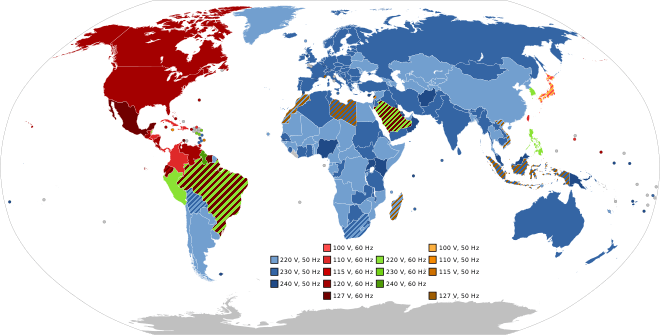
Voltage, frequency, and plug type vary, but large regions may use common standards. Physical compatibility of receptacles may not ensure compatibility of voltage, frequency, or connection to earth (ground), including plugs and cords. In some areas, older standards may still exist. Foreign enclaves, extraterritorial government installations, or buildings frequented by tourists may support plugs not otherwise used in a country, for the convenience of travellers.
Main reference source – IEC World Plugs
The International Electrotechnical Commission publishes a web microsite World Plugs[1] which provides the main source for this page, except where other sources are indicated. World Plugs includes some history, a description of plug types, and a list of countries giving the type(s) used and the mains voltage and frequency.
Although useful for quick reference, especially for travellers, IEC World Plugs may not be regarded as totally accurate, as illustrated by the examples in the plugs section below, and errors may exist, such as Indonesia being listed as using both 220 V and 110 V when the Indonesian Standard SPLN 1[2] clearly states the voltage as 230 V, and the official travel website says "electric power supply is 220 volts in all regions."[3]
Voltages
Voltages in this article are the nominal single-phase supply voltages, or split-phase supply voltages. Three-phase and industrial loads may have other voltages.
All voltages are root mean square voltage; the peak AC voltage is greater by a factor of √2, and the peak-to-peak voltage greater by a factor of 2√2.
Plugs
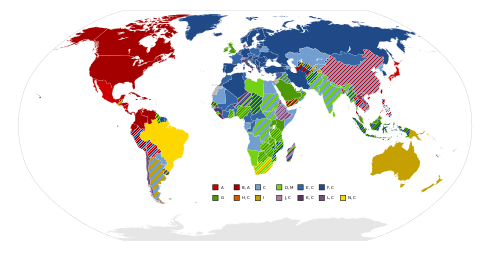
The system of plug types using a single letter (from A to N) used here is from World Plugs, which defines the plug type letters in terms of a general description, without making reference to specific standards. Where a plug does not have a specific letter code assigned to it, then it may be defined by the style sheet number listed in IEC TR 60083.[4] World Plugs gives a (not always correct) list of what plug types are used where. The Type N description is of the two variations of Brazilian plug (Brazilian national standard NBR 14136); however, the original plug and socket is defined in IEC 60906-1 and has been adopted as a South African national Standard (SANS 164-2). The Brazilian version is non-compliant with the IEC standard. Not all plugs are included in the letter system; for example, there is no designation for the plugs defined by the Thai National Standard TIS 116-2549, though some web sites refer to the three-pin plug described in that standard as "Type O".
Identification guide
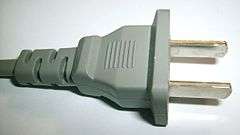

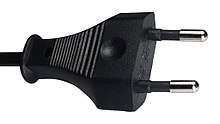
 CEE 7/17 2-pin plug & CEE 7/1 socket
CEE 7/17 2-pin plug & CEE 7/1 socket


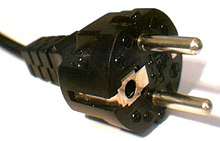
 Type G (BS 1363 UK)
Type G (BS 1363 UK)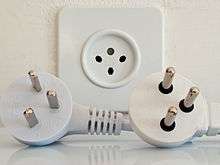 Type H (SI 32 Israel)
Type H (SI 32 Israel) Type I (Australian AS/NZS 3112); Argentinian version has reversed polarity compared to Chinese and Australian versions
Type I (Australian AS/NZS 3112); Argentinian version has reversed polarity compared to Chinese and Australian versions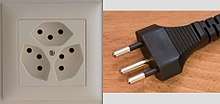 Type J (SEV-1011 Switzerland), 10A
Type J (SEV-1011 Switzerland), 10A Type K (SRAF 1962/DB Denmark)
Type K (SRAF 1962/DB Denmark) Type L (CEI 23-50)
Type L (CEI 23-50) Type M (15 A BS 546)
Type M (15 A BS 546) Type N (NBR 14136, Brazil)
Type N (NBR 14136, Brazil)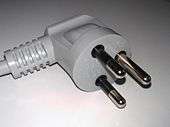 Thai TIS 166-2549 mains plug, sometimes known as Type O[5]
Thai TIS 166-2549 mains plug, sometimes known as Type O[5]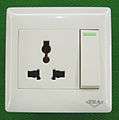 So-called "universal socket" which meets no standard[6] but accepts a number of different plug types (criticized as unsafe)
So-called "universal socket" which meets no standard[6] but accepts a number of different plug types (criticized as unsafe)
Table of mains voltages, frequencies, and plugs
| Country or territory |
Plug type[lower-alpha 1] | National plug standard[4] | Residential voltage[7] |
Three-Phase
Voltage (L-L) |
Frequency[7] | Notes |
|---|---|---|---|---|---|---|
| Afghanistan | C, F | 220 V | 380 V | 50 Hz | ||
| Albania | C, F | 230 V | 400 V | 50 Hz | ||
| Algeria | C, F | 230 V | 400 V | 50 Hz | ||
| American Samoa | A, B, F, I | 120 V | 208 V | 60 Hz | ||
| Andorra | C, F | 230 V | 400 V | 50 Hz | ||
| Angola | C | 220 V | 380 V | 50 Hz | ||
| Anguilla | A | 110 V | 120/208 V 127/220 V 240/415 V |
60 Hz | ||
| Antigua and Barbuda | A, B | 230 V | 400 V | 60 Hz | ||
| Argentina | C, I | 230 V[8] | 380 V | 50 Hz | Line/neutral reversed compared to Chinese and Australian/NZ Type I | |
| Armenia | C, F | 230 V | 400 V | 50 Hz | ||
| Aruba | A, B, F | 127 V | 220 V | 60 Hz | ||
| Australia | I | AS/NZS 3112 | 230 V[9] | 400 V | 50 Hz | Bathrooms may have shaver supply units Line/neutral reversed compared to Argentinian Type I |
| Austria | C F | ÖVE-IG/EN 50075 ÖVE/ÖNORM E 8620 | 230 V | 400 V | 50 Hz | |
| Azerbaijan | C, F | 230 V | 380 V | 50 Hz | ||
| Bahamas | A, B | 120 V | 208 V | 60 Hz | ||
| Bahrain | G | 230 V | 400 V | 50 Hz | ||
| Bangladesh | C, D, G, K | 220 V | 380 V | 50 Hz | ||
| Barbados | A, B | 115 V | 200 V | 50 Hz | ||
| Belarus | C, F | 220 V | 380 V | 50 Hz | ||
| Belgium | C, E | NBN C 61 112-1 | 230 V | 400 V | 50 Hz | |
| Belize | A, B, G | 110 V 220 V |
190 V 380 V |
60 Hz | ||
| Benin | C, E | 220 V | 380 V | 50 Hz | ||
| Bermuda | A, B | 120 V | 208 V | 60 Hz | ||
| Bhutan | C, D, F, G, M | 230 V | 400 V | 50 Hz | ||
| Bolivia | A, C | 115 V 230 V |
400 V | 50 Hz | ||
| Bonaire,[10][11][12][13] Sint Eustatius and Saba | A, B | 127 V | 220 V | 50 Hz | Sockets for 220-240 V European type C plugs are typically available at hotels; some buildings modify voltage, so travellers are advised to check before plugging in. Type F are also available at some hotels. | |
| Bosnia and Herzegovina | C, F | 230 V | 400 V | 50 Hz | ||
| Botswana | D, G, M | 230 V | 400 V | 50 Hz | ||
| Brazil | C, N | NBR 14136 | 127 V 220 V[14] |
220 V 380 V |
60 Hz[15] | |
| British Virgin Islands | A, B | 110 V | 190 V | 60 Hz | ||
| Brunei | G | 240 V | 415 V | 50 Hz | ||
| Bulgaria | C, F | 230 V | 400 V | 50 Hz | ||
| Burkina Faso | C, E | 220 V | 380 V | 50 Hz | ||
| Burundi | C, E | 220 V | 380 V | 50 Hz | ||
| Cambodia | A, C, G | 230 V | 400 V | 50 Hz | Sockets for British type G plugs are mainly found at some hotels, but never in households. | |
| Cameroon | C, E | 220 V | 380 V | 50 Hz | ||
| Canada | A B NEMA 14-30 NEMA 14-50 | CSA C22.2 No. 42[16] | 120 V 120 V[17] 240 V 240 V |
120/208 V 240 V 277/480 V 347/600 V |
60 Hz | Homes are typically provided with 120/240 V split-phase power; NEMA 14-30R and 14-50R receptacles are provided on 240 V circuits for clothes dryers and electric stoves.[18] |
| Cape Verde | C, F | 220 V | 400 V | 50 Hz | ||
| Cayman Islands | A, B | 120 V | 240 V | 60 Hz | ||
| Central African Republic | C, E | 220 V | 380 V | 50 Hz | ||
| Chad | C, D, E, F | 220 V | 380 V | 50 Hz | ||
| Chile | C, F, L | 220 V | 380 V | 50 Hz | Schuko or type F plugs are often used for high power appliances. | |
| China (mainland) | A, C, I | GB 1002-2008 & GB 2099.1‐2008 | 220 V | 380 V | 50 Hz | Line/neutral reversed compared to Argentinian Type I |
| Colombia | A, B | 120 V[19] | 208 V 220 V 260 V 440 V |
60 Hz[20] | ||
| Comoros | C, E | 220 V | 380 V | 50 Hz | ||
| Congo, Republic of the | C, E | 230 V | 380 V | 50 Hz | ||
| Congo, Democratic Republic of the | C, D, E | 220 V | 400 V | 50 Hz | ||
| Cook Islands | I | 240 V | 415 V | 50 Hz | ||
| Costa Rica | A, B | 120 V | 208 V 240 V 480 V[21] |
60 Hz | ||
| Côte d'Ivoire | C, E | 230 V | 380 V | 50 Hz | ||
| Croatia | C, F | 230 V | 400 V | 50 Hz | ||
| Cuba | A, B | 110 V | 190 V | 60 Hz | Some modern hotels have 220 V sockets for European 2-pin plugs (Type C).[22] | |
| Curaçao | A,[23] B | 127 V[23][24] | 220 V 380 V |
50 Hz[23] | ||
| Cyprus | G | 240 V | 400 V | 50 Hz | ||
| Czech Republic | C, E | ČSN 35 4516 | 230 V | 400 V | 50 Hz | |
| Denmark | C E, F, K | DS/EN 50075 DS 60884-2-D1[25] | 230 V | 400 V | 50 Hz | |
| Djibouti | C, E | 220 V | 380 V | 50 Hz | ||
| Dominica | D, G | 230 V | 400 V | 50 Hz | ||
| Dominican Republic | A, B | 110 V | 120/208 V 277/480 V |
60 Hz | ||
| Ecuador | A, B | 120 V | 208 V 480 V |
60 Hz | ||
| Egypt | C, F | 220 V | 380 V | 50 Hz | ||
| El Salvador | A, B | 115 V | 208 V 220 V 440 V 480 V[26] |
60 Hz | ||
| Equatorial Guinea | C, E | 220 V | [unavailable] | 50 Hz | ||
| Eritrea | C, L | 230 V | 400 V | 50 Hz | ||
| Estonia | C, F | 230 V | 400 V | 50 Hz | ||
| Eswatini | M | 230 V | 50 Hz | |||
| Ethiopia | C, E, F, L | 220 V | 380 V | 50 Hz | Type E very rare because Ethiopia never had French influences. | |
| Falkland Islands | G | 240 V | 415 V | 50 Hz | ||
| Faroe Islands | C, E, F, K | 230 V | 400 V | 50 Hz | ||
| Fiji | I | 240 V | 415 V | 50 Hz | ||
| Finland | C F | SFS-EN 50075 SFS 5610 | 230 V | 400 V | 50 Hz | |
| France | C E | NF EN 50075 NF C 61-314 | 230 V | 400 V | 50 Hz | |
| French Guiana | C, D, E | 220 V | 380 V | 50 Hz | ||
| French Polynesia | A, B, C, E, F | 110 V 220 V |
60 Hz[27] | |||
| Gabon | C | 220 V | 380 V | 50 Hz | ||
| Gambia | G | 230 V | 400 V | 50 Hz | ||
| Georgia | C, F | 220 V | 380 V | 50 Hz | ||
| Germany | C F IEC 60309 | DIN VDE 0620 DIN 49441 DIN EN 60309 | 230 V | 400 V | 50 Hz | |
| Ghana | D, G | 230 V | 400 V | 50 Hz | ||
| Gibraltar | C, G | 240 V | 400 V | 50 Hz | ||
| Greece | C, F | 230 V | 400 V | 50 Hz | ||
| Greenland | C, E, F, K | 220 V | 400 V | 50 Hz | ||
| Grenada | G | 230 V | 400 V | 50 Hz | ||
| Guadeloupe | C, D, E | 230 V | 400 V | 50 Hz | ||
| Guam | A, B | 110 V | 190 V | 60 Hz | ||
| Guatemala | A, B | 120 V | 208 V | 60 Hz | ||
| Guernsey | G | 230 V | 415 V | 50 Hz | ||
| Guinea | C, F, K | 220 V | 380 V | 50 Hz | ||
| Guinea-Bissau | C | 220 V | 380 V | 50 Hz | ||
| Guyana | A, B, D, G | 110 V 220 V[28] |
190 V | 60 Hz 50 Hz[28] | Conversion of 50 Hz distribution to 60 Hz is ongoing[29] | |
| 220/380 V | 50 Hz | |||||
| 230/460 V | 60 Hz | |||||
| Haiti | 220 V | 220/380 V | 50 Hz | |||
| A, B | 110 V | 110/220 V | 60 Hz | |||
| Honduras | A, B | 110 V | 208 V 230 V 240 V 460 V 480 V |
60 Hz | ||
| Hong Kong | G D, M[30] | BS 1363 BS 546 | 220 V | 380 V | 50 Hz | Type G is most common. |
| Hungary | C F | MSZ EN 50075 MSZ 9781-2 | 230 V | 400 V | 50 Hz | |
| Iceland | C, F | 230 V | 400 V | 50 Hz | ||
| India | C, D, M | IS 1293[31] | 230 V | 400 V | 50 Hz | |
| Indonesia | A, C, F, G | SNI 04-3892 | 220 V[2] | 380 V | 50 Hz | British Type G sockets are common in Riau Islands Province (Batam, Bintan, etc.) due to close proximity to Singapore. British Type G sockets also being used for air conditioner where most air conditioner draws more current than the most sockets rating in Indonesia. Wall sockets in most homes in North Sumatra (in cities such as in Medan & Pematangsiantar) generally accept both Type A and Type C plugs. |
| Iran | C, F | 220 V | 400 V | 50 Hz | ||
| Iraq | C, D, G | 230 V | 400 V | 50 Hz | ||
| Ireland | G | I.S. 401[32] | 230 V | 415 V | 50 Hz | |
| Isle of Man | G | 240 V | 415 V | 50 Hz | ||
| Israel | C, H, M | 230 V | 400 V | 50 Hz | Several territories controlled by the PNA also share the same type as the State of Israel. | |
| Italy | C F, L | CEI 23-34 CEI 23-50 | 230 V | 400 V | 50 Hz | Different type L plugs are used for high-current vs. low-current devices |
| Jamaica | A, B | 110 V | 190 V | 50 Hz | ||
| Japan | A, B | JIS C 8303 | 100 V 200 V |
200 V 415 V |
50 Hz 60 Hz | East Japan 50 Hz (Tokyo, Kawasaki, Sapporo, Yokohama, and Sendai); West Japan 60 Hz (Okinawa, Osaka, Kyoto, Kobe, Nagoya, Hiroshima). 120 V in military facilities in Okinawa.[33] See Energy in Japan for more. |
| Jersey | G | 230 V | 415 V | 50 Hz | ||
| Jordan | B, C, D, F, G, J | 230 V | 400 V | 50 Hz | ||
| Kazakhstan | C, F | 220 V | 380 V | 50 Hz | ||
| Kenya | G | 240 V | 415 V | 50 Hz | ||
| Kiribati | I | 240 V | [unavailable] | 50 Hz | ||
| Kosovo | C, F | 230 V | 230 V 400 V |
50 Hz | ||
| Kuwait | C, G | 240 V | 415 V | 50 Hz | ||
| Kyrgyzstan | C, F | 220 V | 380 V | 50 Hz | ||
| Laos | C, E, F | 230 V | 400 V | 50 Hz | Some buildings and households have double use sockets compatible with type A, B and C. | |
| Latvia | C, F | 230 V | 400 V | 50 Hz | ||
| Lebanon | A, B, C, D, G | 220 V | 400 V | 50 Hz | Type C sockets are the most frequent. Many buildings and households have double use sockets compatible with type A and C. | |
| Lesotho | M | 220 V | 380 V | 50 Hz | ||
| Liberia | A, B, C, E, F | 120 V 240 V |
208 V - |
60 Hz 50 Hz | ||
| Libya | C, D, F, L | 127 V | 400 V | 50 Hz | Barca, Benghazi, Derna, Sabha & Tobruk 230 V. | |
| Lithuania | C, F | 230 V | 400 V | 50 Hz | ||
| Liechtenstein | C, J | 230 V | 400 V | 50 Hz | ||
| Luxembourg | C, F | 230 V | 400 V | 50 Hz | ||
| Macau | D, F, G, M | 230 V[34] | 380 V | 50 Hz | ||
| Madagascar | C, D, E, J, K | 127 V 220 V |
380 V | 50 Hz | ||
| Malawi | G | 230 V | 400 V | 50 Hz | ||
| Malaysia | C[35] G[35] M[35][36] | MS 1578:2003[35] MS 589:PT.1:1997[35] MS 1577:2003[35] | 230 V[37] | 400 V | 50 Hz | Type C requires adaptor[38] Bathrooms may have shaver supply units[38] |
| Maldives | D, G, J, K, L | 230 V | 400 V | 50 Hz | ||
| Mali | C, E | 220 V | 380 V | 50 Hz | ||
| Malta | G | 230 V | 400 V | 50 Hz | ||
| Martinique | C, D, E | 220 V | 380 V | 50 Hz | ||
| Mauritania | C | 220 V | 220 V | 50 Hz | ||
| Mauritius | C, E, G | 230 V | 400 V | 50 Hz | ||
| Mexico | A, B | NMX-J-163-ANCE | 127 V | 220 V 480 V |
60 Hz | |
| Micronesia | A, B | 120 V | [unavailable] | 60 Hz | ||
| Moldova | C, F | 220 V | 400 V | 50 Hz | ||
| Monaco | C, D, E, F | 230 V | 400 V | 50 Hz | ||
| Mongolia | C, E | 220 V | 400 V | 50 Hz | ||
| Montenegro | C, F | 230 V | 400 V | 50 Hz | ||
| Montserrat | A, B | 120 V 230 V |
400 V | 60 Hz | ||
| Morocco | C, E | 127 V 220 V |
380 V | 50 Hz | ||
| Mozambique | C, F, M | 220 V | 380 V | 50 Hz | ||
| Myanmar | C, D, F, G | 230 V | 400 V | 50 Hz | ||
| Namibia | D, M | 220 V | 380 V | 50 Hz | ||
| Nauru | I | 240 V | 415 V | 50 Hz | ||
| Nepal | C, D, M | 230 V | 400 V | 50 Hz | ||
| Netherlands | C, F | EN 50075 NEN 1020 | 230 V | 400 V | 50 Hz | |
| New Caledonia | C, F | 220 V | 380 V | 50 Hz | Despite that New Caledonia is a French territory, German Schuko Type F sockets are used instead of French Type E sockets. | |
| New Zealand | I | AS/NZS 3112 | 230 V | 400 V | 50 Hz | Line/neutral reversed compared to Argentinian Type I |
| Nicaragua | A, B | 120 V | 208 V | 60 Hz | ||
| Niger | A, B, C, D, E, F | 220 V | 380 V | 50 Hz | ||
| Nigeria | D, G | 240 V | 415 V | 50 Hz | ||
| North Korea | A, C, F | 110 V 220 V |
380 V - |
60 Hz 50 Hz | ||
| North Macedonia | C, F | 230 V |
400 V | 50 Hz | ||
| Norway | C F | NEK EN 50075 NEK 502 | 230 V |
230 V 400 V |
50 Hz | |
| Oman | C, G | 240 V | 415 V | 50 Hz | ||
| Pakistan | C, D, G, M | 230 V | 400 V | 50 Hz | ||
| Palau | A, B | 120 V | 208 V | 60 Hz | ||
| Panama | A, B | 110 V 120 V |
240 V | 60 Hz | ||
| Papua New Guinea | I | 240 V | 415 V | 50 Hz | ||
| Paraguay | C | 220 V | 380 V | 50 Hz | ||
| Peru | A, B, C F, L[39] |
220 V | 380 V 440 V |
60 Hz | Talara 110/220 V; some areas 50 Hz[40] | |
| Philippines | A, B, C | 230 V[41] | 220 V 440 V |
60 Hz | ||
| Poland | C, E | BN-88/3064 | 230 V | 400 V | 50 Hz | |
| Portugal | C, E, F | NP 1260 | 230 V | 400 V | 50 Hz | Type E very rare, but used in very old installations. |
| Puerto Rico | A, B | 120 V | 480 V | 60 Hz | ||
| Qatar | D, G | 240 V | 415 V | 50 Hz | ||
| Réunion | E | 220 V | 400 V | 50 Hz | ||
| Romania | C, F | 230 V | 400 V | 50 Hz | ||
| Russia | C, F | 230 V[42] | 380 V | 50 Hz | USSR (along with much of Eastern Europe) used GOST sockets with 4.0 mm pins similar to Type C plugs and the 4.8 mm standard used by Type E & F.[43] | |
| Rwanda | C, J | 230 V | 400 V | 50 Hz | ||
| Saint Helena, Ascension and Tristan da Cunha | G | 220-240 V | [unavailable] | 50 Hz | ||
| Saint Martin (French) | C, E | 220 V | [unavailable] | 60 Hz | ||
| Sint Maarten (Dutch) | A, B | 120 V | 220 V | 60 Hz | ||
| St. Kitts and Nevis | A, B, D, G | 110 V 230 V |
400 V | 60 Hz | ||
| St. Lucia | G | 240 V | 400 V | 50 Hz | ||
| Saint Pierre and Miquelon | E | 230 V | 50 Hz | |||
| St. Vincent and the Grenadines | C, E, G, I, K | 230 V | 400 V | 50 Hz | ||
| Samoa | I | 230 V | 400 V | 50 Hz | ||
| San Marino | C, F, L | 230 V | 400 V | 50 Hz | ||
| São Tomé and Príncipe | C, F | 220 V | 400 V | 50 Hz | ||
| Saudi Arabia | G | SASO 2203 | 220 V | 400 V | 60 Hz | |
| Senegal | C, D, E, K | 230 V | 400 V | 50 Hz | ||
| Serbia | C F | JUS N.E3.552 JUS N.E3.553 | 230 V | 400 V | 50 Hz | |
| Seychelles | G | 240 V | 240 V | 50 Hz | ||
| Sierra Leone | D, G | 230 V | 400 V | 50 Hz | ||
| Singapore | C G M | - SS 145 SS 472 | 230 V | 400 V | 50 Hz | |
| Slovakia | C, E | STN 34 4516 | 230 V | 400 V | 50 Hz | |
| Slovenia | C, F | 230 V | 400 V | 50 Hz | ||
| Solomon Islands | I, G | 220 V | [unavailable] | 50 Hz | ||
| Somalia | C | 220 V | 380 V | 50 Hz | ||
| South Africa | C, M, N | SANS 164 | 230 V | 400 V | 50 Hz | |
| South Korea | C, F | KS C 8305 | 220 V | 380 V | 60 Hz | |
| Spain | C, F | UNE 20315 | 230 V | 400 V | 50 Hz | Type E is extremely rare, but it may appear in some buildings, such as the University Carlos III of Madrid. Almost every Spanish plug would work on Type E sockets. |
| Sri Lanka | D, G, M | 230 V | 400 V | 50 Hz | Only Type G permitted to be manufactured or imported from August 2017[44] | |
| Sudan | C, D | 230 V | 400 V | 50 Hz | ||
| Suriname | A, B, C, F | 127 V | 220 V 400 V |
60 Hz | Type A and B tend to be very common because standard sockets can't accommodate such voltage. | |
| Sweden | C F | SS-EN 50075 SS 428 08 34 | 230 V | 400 V | 50 Hz | Bathrooms may have shaver supply units. |
| Switzerland | C, J | SN SEV 1011:2009[45][46] | 230 V | 400 V | 50 Hz | |
| Syria | C, E, L | 220 V | 380 V | 50 Hz | ||
| Taiwan | A, B | CNS 10917 | 110 V 220 V |
110 V 380 V |
60 Hz | Sockets in older buildings are often unearthed and accept only Type A plugs. |
| Tajikistan | C, F, I | 220 V | 380 V | 50 Hz | ||
| Tanzania | D, G | 230 V | 415 V | 50 Hz | ||
| Thailand | A, B, C, F | - | 220 V | 400 V | 50 Hz | There is also a Thai national standard, TIS 166-2549 (sometimes known as Type O) which may not yet be in common use.[47][48] |
| Timor-Leste (East Timor) | C, E, F, I | 220 V | 380 V | 50 Hz | ||
| Togo | C | 220 V | 380 V | 50 Hz | ||
| Tonga | I | 240 V | 415 V | 50 Hz | ||
| Trinidad & Tobago | A, B | 115 V | 115/230 V 230/400 V |
60 Hz | ||
| Tunisia | C, E | 230 V | 400 V | 50 Hz | ||
| Turkey | C, F | 220 V[49] | 400 V | 50 Hz | ||
| Turkmenistan | B, C, F | 220 V | 380 V | 50 Hz | ||
| Tuvalu | I | 220 V | 50 Hz | |||
| Uganda | G | 240 V | 415 V | 50 Hz | ||
| Ukraine | C, F | 220 V[50] | 380 V | 50 Hz | ||
| United Arab Emirates | C, G | 220 V | 400 V | 50 Hz | Type G is most common. | |
| United Kingdom | G[51] | BS 1363 | 230 V[52] | 415 V | 50 Hz | Bathrooms may have shaver supply units |
| United States | A B NEMA 14-30 NEMA 14-50 | NEMA 1-15 NEMA 5-15 NEMA 14-30 NEMA 14-50 | 120 V 120 V 240 V 240 V |
120/208 V 277/480 V 120/240 V 240 V 480 V |
60 Hz | NEMA 5-20R outlets, which are similar to type B but have a T-shaped neutral blade, are sometimes used for higher current 120 V equipment (up to 20 A). |
| U.S. Virgin Islands | A B | NEMA 1-15 P NEMA 5-15 P | 110 V | 190 V | 60 Hz | |
| Uruguay | C, F, I, L | 230 V | 380 V | 50 Hz | ||
| Uzbekistan | C, I | 220 V | 380 V | 50 Hz | ||
| Vanuatu | C, G, I | 220 V | 400 V | 50 Hz | ||
| Venezuela | A, B | 120 V | 115/220 V 220/440 V 230/460 V[53] |
60 Hz | ||
| Vietnam | A, C, G | TCVN 6188-1 | 220 V | 380 V | 50 Hz | Sockets for British type G plugs are mainly found at some hotels, but never in households. |
| Yemen | A, D, G | 230 V | 400 V | 50 Hz | ||
| Zambia | C, D, G | 230 V | 400 V | 50 Hz | ||
| Zimbabwe | D, G | 220 V | 415 V | 50 Hz |
- "C" may indicate that buildings have three-pin sockets compatible with Europlugs, which also work with other plug types or that buildings have some or all two-pin European style sockets, similar to CEE 7/1, or that use of an adaptor is common practice. Not all two-pin European plugs are compatible with all two-pin European sockets; see AC power plugs and sockets § Compatibility.
See also
References
- World Plugs. International Electrotechnical Commission (IEC). Retrieved on 2018-06-05.
- SPLN 1 : 1995, Standar PLN. "Tegangan-tegangan Standar". Archived from the original on 4 December 2013. Retrieved 1 December 2013.
- "Before You Go". Indonesia.travel. Ministry of Tourism, Republic of Indonesia. Archived from the original on 23 April 2018. Retrieved 23 May 2018.
- IEC/TR 60083 ed7.0: Plugs and socket-outlets for domestic and similar general use standardized in member countries of IEC. International Electrotechnical Commission, October 2015. This 421-page technical report describes many national standards for domestic plugs and sockets. The first edition was published in January 1957. The 7th edition was approved in December 2012 and was published on 29 October 2015.
- WorldStandards.eu - Power plug & outlet Type O
- "Universal AC Outlet • Setup Guide" (PDF). Anaheim, CA: Extron Electronics. November 2017. 68-1638-01 Rev. F. Archived from the original (PDF) on 16 May 2018. Retrieved 21 May 2018.
- "IEC - World Plugs: List view by location". Retrieved 5 June 2018.
- Reglamentado por AEA90364, IRAM2001 & IEC60083
- When voltage varies. Electrical connection (2012-10-22). Retrieved on 2014-05-24.
- "Electrical Plug/Outlet and Voltage Information for Bonaire". Adaptelec.com.
- "F.A.Q." CaribbeanClubBonaire.com.
- "Technology on Bonaire". InfoBonaire.com.
- "Electricity". CaribInn.com.
- Brasil. Decreto n. 41.019, de 26 de fev. de 1957. Regulamenta os serviços de energia elétrica, BR: BR Government, 1957
- Brasil. Lei n. 4.454, de 06 de nov. de 1964. Dispõe sobre a unificação de frequência da corrente elétrica no País, BR: BR Government, 1964
- CSA Standard C22.2 No. 42-10: General use receptacles, attachment plugs, and similar wiring devices. Mississauga, Ontario: Canadian Standards Association. 2010. p. 1.
- CAN3-C235-83: Preferred Voltage Levels for AC Systems, 0 to 50 000 V. Rexdale (Toronto), Ontario: Canadian Standards Association. 1983. p. 9.
- C22.1-18: Canadian Electrical Code, Part 1. Toronto, Ontario: Canadian Standards Association. 2018. p. 243.
- Colombia. Resolución 90708: Reglamento Técnico de Instalaciones Eléctricas - RETIE, August 30, 2013, CO: Ministry of Mines and Energy, 2013, archived from the original on 11 July 2015, retrieved 16 October 2018
- Colombia. CREG RESOLUCIÓN No. 70, May 28, 1998, CO: Commission for the Regulation of Energy and Gas (CREG), 1998
- Tensiones Transitorias - Boletín Informativo (PDF), CR: CNFL - Compañía Nacional de Fuerza y Luz S.A.
- Cuba: Electricity - TripAdvisor
- "Curaçao Utilities". Curaçao Tourist Board. Retrieved 28 June 2017.
- Confirmed 127V by looking at Aqualetric residential electricity meter
- Dansk Standard. "DS 60884-2-D1:2011 - Plugs and socket-outlets for household and similar purposes - Requirements for Danish systems". webshop.ds.dk.
- Netzspannungen Weltweit (PDF), Fuhrmeister + Co GmbH, 2020
- (PDF)(French) Page 10, Article 9
- History of Guyana Power and Light Archived 30 April 2018 at the Wayback Machine. Gplinc.com. Retrieved on 2014-01-01.
- GPL Converting Parts of the City to 60 Hz, retrieved 2009 July 31. Stabroeknews.com (2009-07-10). Retrieved on 2014-01-01.
- "Code of Practice for the Electricity (Wiring) Regulations" (PDF). Electrical and Mechanical Services Department. p. 221. Retrieved 28 May 2016.
- October 2005. IS 1293 - Indian Standard - PLUGS AND SOCKET-OUTLETS OF RELATED VOLTAGE UP TO AND INCLUDING 250 VOLTS AND RATED CURRENT YP TO AND INCLUDING 16 AMPERES -- SPECIFICATION. Bureau of Indian Standards.
- I.S. 401, "Safety requirements for rewirable and non-rewirable 13A fused plugs for normal and rough use having insulating sleeves on line and neutral pins", NSAI (National Standards Authority of Ireland), (1997), Dublin
- MC&FP, Military Community Outreach. "MilitaryINSTALLATIONS - U.S. Department of Defense". www.militaryinstallations.dod.mil. Retrieved 13 July 2018.
- Standard Conditions of Supply of Electricity. (Macau). Archived from the original 2016-06-03. Retrieved on 2016-04-14
- Plug Top/Plug (15 A and below) -Energy Commission of Malaysia. Archived from the original 2015-01-07.
- "Guidelines For Electrical Wiring In Residential Buildings" (PDF) (2008 ed.). Energy Commission of Malaysia.
- Voltan Nominal. Malaysian Energy Commission Notice (Nominal Voltage - 2008-01-01). Retrieved on 2019-02-11
- Socket Outlet (15 A and below) Archived 2015-01-07 at the Wayback Machine Energy Commission of Malaysia. (MS 1579:2003 is adaptor for Europlugs.)
- "MEM recomienda qué tipo de tomacorrientes se deben utilizar". Diario Correo (in Spanish). 24 January 2016. Retrieved 26 August 2019.
- Dilwyn Jenkins, The Rough Guide to Peru 2003 Rough Guides, ISBN 1-84353-074-0, p. 57
- Philippine Electrical Code, section 2.20.1.5 (a)
- "Standard Voltages". docs.cntd.ru. Document gost-29322-92 via Google Translate: "The nominal voltages of the existing 220/380 and 240/415 V networks should be reduced to the recommended value of 230/400 V. Until 2003, as a first stage, power supply companies in countries with a 220/380 V network should lead the voltage to The value of 230/400 V (GOST 29322-92 (IEC 38-83) Standard voltage%). Electricity supply companies in countries with 240/415 V network should also bring this voltage to the value 230/400 V (GOST 29322-92 (IEC 38-83) Standard voltage%). After 2003, the range of 230/400 V ± 10% should be reached. Then, the issue of reducing the limits will be considered."
- ГОСТ 7396.1–89 - Plugs (Electrical) and socket-outlets for domestic and similar general use. Standards. Elec.ru (2013-01-30). Retrieved on 2013-02-05.
- "New standards for 13A plugs and socket outlets manufactures & importers" (Press release). Public Utilities Commission of Sri Lanka. 13 June 2018.
- "Information SEV 1011 – power socket/plug/connector" (PDF). esti.admin.ch (PDF). Federal Inspectorate for Heavy Current Installations ESTI, Swiss Confederation. 1 August 2011. Archived from the original (PDF) on 25 April 2012. Retrieved 22 August 2014.
- "New standard for plugs in Switzerland starting from 2013" (PDF) (PDF). Federal Inspectorate for Heavy Current Installations ESTI, Swiss Confederation. 13 May 2011. Retrieved 22 August 2014.
- TIS 166-2549 (2006): Thai Industrial Standards for Plugs and socket-outlets for household and similar purposes : plugs and socket-outlets with rated voltage not exceeding 250 V (English translation) Archived from the original 2016-07-07.
- TIS 166-2549 (2006) THAI INDUSTRIAL STANDARD - PLUGS AND SOCKET–OUTLETS FOR HOUSEHOLD AND SIMILAR PURPOSES : PLUGS AND SOCKET–OUTLETS WITH RATED VOLTAGE NOT EXCEEDING 250 V (Original Thai) ISBN 974-9815-94-7
- Turkish Electric Plugs & Sockets. Retrieved on 2017-03-26.
- ДСТУ ЕN 50160:2014
- Mullins, Malcolm (Spring 2006). "The Origin of the BS 1363 Plug and Socket-Outlet System". IEE Wiring Matters. Institute of Electrical Engineers. Archived from the original on 3 March 2016. Retrieved 16 October 2016.
- The Electricity Safety, Quality and Continuity Regulations 2002 PART VII Regulation 27, UK: UK Government, 2002
- "International Mains Voltages" (PDF). International Mains Voltages - Pooley Inc. SEW Eurodrive. Retrieved 15 January 2020.
External links

